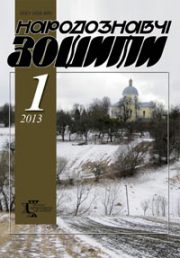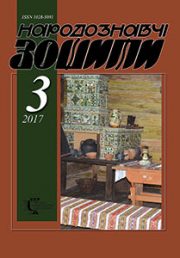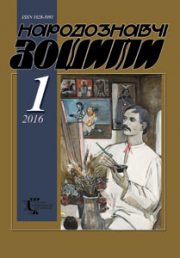The Ethnology Notebooks. 2020. № 2 (152), 311—322
UDK 39:728-057.2](477)
DOI https://doi.org/10.15407/nz2020.02.311
MASTER BUILDER AS A INTERMEDIARY BETWEEN HOUSING AND ENVIRONMENT
FAYNYK Tetyana
ORCID ID: https://orcid.org/0000-0001-8446-4002
Doctor of Sciences in History, Senior Researcher
in the Institute of Ethnology, Ethnology of Modernity Department:
National Academy of Sciences,
15, Svobody Avenue, 79000, Lviv, Ukraine,
Contacts: e-mail: t.faynyk@gmail.com
Abstract. The task of the article is to reveal the spiritual aspect in a purely professional problem: the master is a dwelling place — the environment, because every stage of construction was accompanied by a large number of common actions, rituals, rituals, warnings and moral taboos, so special importance was given to the behavior and attitude of the master himself. For the first time the usual norms of the masters’ behavior, their understanding of nature, preparation for work, the spiritual world, place in society, relationships with the master-customer, rituals that accompanied the whole process of construction were established. The standards of value sides of work of construction masters are shown. There is a distinctive action with a cod («rolling pin»), which has a magical meaning and defines the relationship between the master — the master — the environment. The originality of the ceremonial action «Lord’s Farewell», built on the worship of the pure, unharmed, healthy hands of the master, which symbolize the future well-being of the residents of the house and demonstrate the high professionalism of the master, is revealed. Scientific and practical recommendations that follow from the content of the article: To offer further and deeper study of folk traditions, focusing on attentive attitude to the use of natural building resources, their harvesting, preservation, common ways of preserving wood and raising the level of building culture of the master and customer to contribute to the harmonization of relations of modern man with the environment, with nature, with space.
Keywords: people’s habitation, craftsman, environment, ritual, traditions, customs, construction.
Received 17.04.2020
REFERENSES
Fainyk, T. Report on the scientific expedition of Scole region; 06.07—20.07.2019. In The Archive of Institute of Ethnology of the National Academy of Sciences of Ukraine. Materials of expeditions (Exp. 384) [in Ukrainian].
Fainyk, T. Report on the scientific expedition of Boykivshchyna region; 01.06—16.06.1998. In The Archive of Institute of Ethnology of the National Academy of Sciences of Ukraine. Materials of expeditions (Exp. 408) [in Ukrainian].
Fainyk, T. Report on the scientific expedition of Zakarpattya region; 03.07—10.07.2001. In The Archive of Institute of Ethnology of the National Academy of Sciences of Ukraine. Materials of expeditions (Exp. 425) [in Ukrainian].
Fainyk, T. Report on the scientific expedition of Ivano-Frankivs’k region; 03.07—10.07.1999. In The Archive of Institute of Ethnology of the National Academy of Sciences of Ukraine. Materials of expeditions (Exp. 428) [in Ukrainian].
Vincens, S. (1997). On a high polonyna. Lviv: Chervona Kalyna (in Ukrainian).
Goshko, Yu.G. (1976). The population of the Ukrainian Carpathians of the XV—XVIII centuries: Population. Migrations Everyday life. (Academy of Sciences of the USSR — State Museum of Ethnography and Arts). Kyiv: Naykova dymka [in Ukrainian].
Danyluk, A. (1995). Worship the People’s Architect. Ethnographic essays on folk architecture of Ukraine. Lviv: Monastery of the Monks of the Studio Charter. Swichado [in Ukrainian].
Zaglada, N. (1929). Life of a peasant child. Kyiv [in Ukrainian].
Zdorovega, N.I. (1983). Folk customs and rituals. Boykivshchyna. Historical and ethnographic research (Pp. 232—248). Kyiv: Naukova dumka [in Ukrainian].
Zubrytsky, M. (1900). Folk calendar, folk customs and beliefs tied to the days of the week and the annual holidays. Materials on Ukrainian-Russian ethnology (Vol. 3, pp. 33—60) [in Ukrainian].
Makovij, Garaffina. (1993). Great-grandfather’s house. Blurred color (Pp. 66—69). Kyiv: The Ukrainian Writer [in Ukrainian].
Onishkevich, M.I. (1984). Glossary of Boykiv dialects in two volumes (Part I, II). Kyiv: Naukova dumka [in Ukrainian].
Radovich, R. (2008). Customs and Rites Related to the Construction of Housing in the West of Halych Boikivshchyna (according to the materials of the Turkivsky and Starosambirsky Districts). The Ethnology Notebooks, 3—4, 253—271. Lviv [in Ukrainian].
Siletskyi, R. (2011). Traditional building ritual of Ukrainians. Lviv: Ivan Franko National University of Lviv [in Ukrainian].
Sichinskyi, V. (1956). History of Ukrainian Art. Architecture (Vol. 1). New York [in Ukrainian].
Syavavko, E. (1987). Family ritual. Hutsul region. Historical and ethnographic research (Pp. 302—319). Kyiv: Naukova dumka [in Ukrainian].
Tyshchenko, O. (1992). History of decorative and applied art of Ukraine (XIII—XVIII centuries). Kyiv: Lybid [in Ukrainian].
Faynyk, T. (2007). Habitation and environment: building traditions of Ukrainians in Carpathians. Lviv [in Ukrainian].
Faynyk T. (1998). National master builder and his social status in the Ukrainian Carpathians and Carpathians. Ethnos. Culture. Nation. Proceedings of the International Scientific Conference 29—31 October (Pp. 156—161). Drohobych [in Ukrainian].
Shcherbakivskyi, V. (1995). Ukrainian Art. Kyiv: Lybid [in Ukrainian].
Yurchenko, P.G. (1970). Wood architecture of Ukraine. Kyiv: The Builder [in Ukrainian].
Baiburin, A.K. (1983). Housing in the rites and representations of the Eastern Slavs. Leningrad: Nauka [in Russian].
Bromley, Yu.V. (1981). Culture and Ethnic Aspects of Ecology. Society and nature. Historical stages and forms of interaction. Moskva [in Russian].
Kim, M.P., & Danilovich, L.V. (1981). Natural and social in the historical process. Society and nature. Historical stages and forms of interaction. Moskva [in Russian].
Tsivyan, T.V. (1978). House in the folk model of the world (on the materials of Balkan mysteries). Works on sign systems, 10, 65—74. Tartu [in Russian].
Shayn, P.V. (1890). Materials for the study of the everyday life and language of the Russian population of the Northwest Territory (Vol. 1, part 2). St. Petersburg [in Russian].






